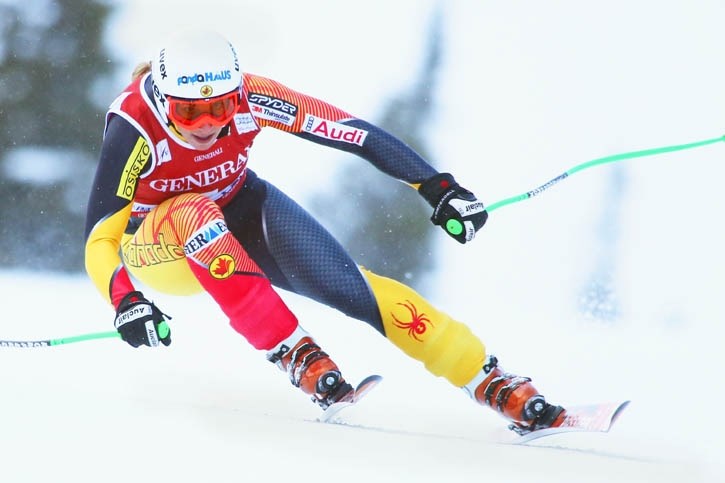With the women’s speed team firmly stuck in rebuilding mode, Alpine Canada president Max Gartner says patience is needed before the nation sees a resurgence in downhill and super G competitors.
Larisa Yurkiw was the lone Canadian to suit up for Canada at the Dec. 1-3 Bombardier Lake Louise World Cup downhill races and finished well back, even though as host nation there were more starting spots to use.
Kelly Vanderbeek is Canada’s only other World Cup speed racer, but isn’t expected to return to action until the New Year, following a three-year comeback.
“After the retirements and the injuries, the next generation of athletes was on the tech side. We have a strong slalom team, but we are thin on the speed side. Larisa is coming back and has a chance to come on the top 15 soon. Behind that, we’re trying to build a new program, but we have to be patient,” Gartner said.
The Bow Valley has produced its share of promising racers, however, since Canada doesn’t have a development program, those skiers are no longer with the national program.
Kelly McBroom and Tess Davies both earned World Cup debuts at Lake Louise in 2010 and 2011 respectively, but both are no longer with the national team program. McBroom is skiing with the University of Montana, while Davies finished eighth in the NorAm downhill over the weekend. She, along with several other young female speed racers, are trying to guarantee a spot on the national team by earning a NorAm spot.
Gartner, meanwhile, wants to make sure when Canadians reach the World Cup, they’re set up for success.
“We don’t want to throw them to the wolves when they’re not ready for that. It will take patience to have strong team. We are focusing on (speed), because that’s where the tradition lies. By 2018, we’ll have a team ready that’s competitive. Not just one athlete, but a strong team,” Gartner said.
Emily Brydon and Britt Janyk’s retirements left holes on the team which Canada wasn’t able to fill. Gartner said injuries and ski cross also stole from Canada’s developing young skiers.
“It was a combination of retirements after 2010 and the next generation also got hurt. Some of them went to ski cross. Kelsey Serwa was coming through the ranks and decided to go to downhill. So did Georgia Simmerling. We are developing athletes for ski cross as well.
“The mandate is to win medals. Sometimes we have to focus on what the chances are. In the old days, the whole focus was on speed only, that’s why we haven’t won a slalom race in 41 years. The sport has changed. We have to be able to turn better in downhill. It’s important they become good tech skiers, then cross over into speed,” Gartner said.
Adam Hull, president of Alberta Alpine, said changes have to be made to give Canadian women a direct route to the national team program.
“We desperately need a development team in this country. There has to be a clear pathway for young racers to reach the national team. Right now, provincial teams have to do more and more to keep kids competitive,” said Hull. “There is a massive jump from NorAms to the World Cup – a jump that can take years. As such, in the absence of a national development team, provincial teams in Canada are having to do more than ever before with limited resources.”
In Alberta, there is plenty of terrain on which to train, and Hull wants young developing skiers training on courses such as the Lake Louise World Cup run.
"We see the cancellation of the NorAm at Lake Louise as incredibly unfortunate. For the sake of developing our next generation of 'Canadian Cowboys' or 'Speed Queens' we need access to such a world class track. This should be thought of as our Canadian advantage. We're committed to working closely with Winterstart Events, Alpine Canada and Lake Louise Ski Resort with the hope of bringing the event back in December of 2013."
Gartner is confident Yurkiw can handle the World Cup this season and predicts more technical racers may switch to speed as their careers develop.
“Marie-Michelle Gagnon is a skier that can eventually ski downhill, but we’re not going to rush that.,” he said. “We want to make sure she becomes solid before she moves across. Lindsey Vonn was a slalom skier first. Maria Reisch was a technical skier first.”
Hull and Gartner agree a strong technical background is key to success, but Hull says speed training is still necessary.
“We want well-rounded skiers,” said Hull. “The foundation for the sport is strong technical skills. That being said, in a speed environment, there’s no replacement for putting time on task. If you only spend two days a year racing (speed), you’re going to put in corresponding training, which makes it even more dangerous.”
While the Canadians struggle, the American women’s speed team is stronger than ever. Lindsey Vonn won her 12th and 13th downhill ahead of teammate Stacey Cook as Americans took the top spots on the podium both days. For Cook, it was her first World Cup win in 150 starts and the first race in three years her parents were able to see.




